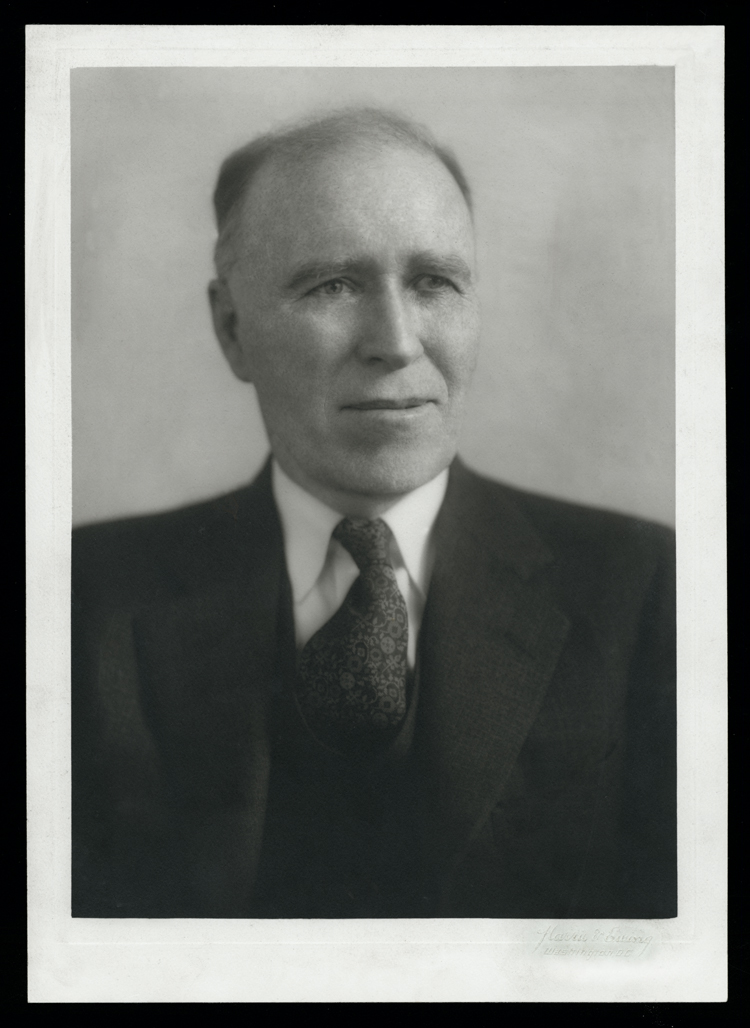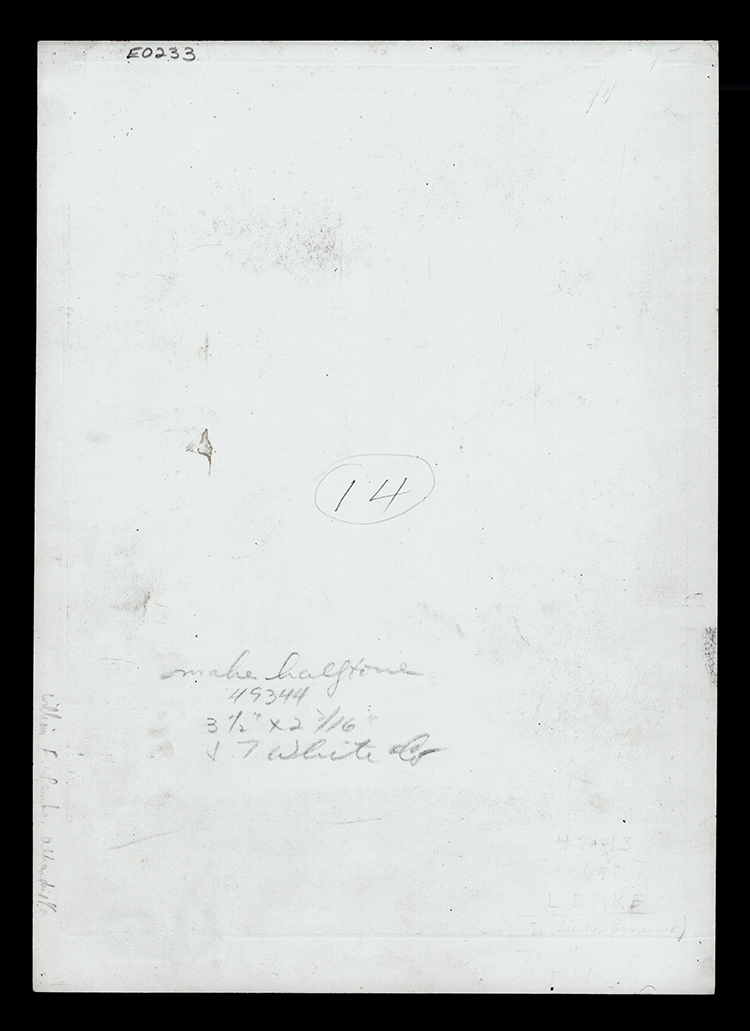Collection: E - E Collection
Folder: 0000.000
Item: 0233_00001
Title: William Frederick Lemke
Date: 6/15/1943
Creator: Harris and Ewing
Inscription/Marks: [in pencil on back of photograph E0233-00001 William F. Lemke [unreadable] 14 make halftone 49344. 3-1/2" x 2-3/16. J. T. White & Co. [Embossing at bottom right of photograph] Harris & Ewing Washington D.C. [ Embossed on portrait folder] (HE) Harris & Ewing, Washington D.C..
Summary: Head and shoulders, full face portrait of William Frederick Lemke taken in Washington D.C. by Harris and Ewing studios during his service in the United State House of Representives. __William Frederick Lemke (August 13, 1878 – May 30, 1950) was a United States politician. He represented North Dakota in the United States House of Representatives as a member of the Republican Party. He was also the Union Party's presidential candidate in the 1936 presidential election. He was born in Albany, Minnesota, and raised in Towner County, North Dakota, the son of Fred Lemke and Julia Anna Kleir, pioneer farmers who had accumulated some 2,700 acres (11 km2) of land. As a boy, Lemke worked long hours on the family farm, attending a common school for only three months in the summers. However, the family did reserve enough money to send him to the University of North Dakota, where he was not only a superior student, but also well known for his ability to impersonate the professors. Graduating in 1902, he stayed at the state university for the first year of law school but moved to Georgetown University, then to Yale Law School, where he finished work on his law degree and won the praise of the dean. He returned to his home state in 1905 to set up practice at Fargo. Lemke was a Freemason. Lemke was the attorney general of North Dakota from 1921 to 1922. He later was elected to the United States House of Representatives in 1932, an NPLer. He served four two-year terms in Congress. While in Congress, Lemke earned a reputation as a progressive populist and supporter of the New Deal, championing the causes of family farmers and co-sponsoring legislation to protect farmers against foreclosures during the Great Depression. In 1934, Lemke co-sponsored the Frazier–Lemke Farm Bankruptcy Act, restricting the ability of banks to repossess farms. President Franklin D. Roosevelt signed the act into law on June 28, 1934. The Act was later ruled unconstitutional by the Supreme Court in Louisville Joint Stock Land Bank v. Radford. Lemke tried to get the Act re-passed by Congress, but was stymied by the Roosevelt administration which privately told Congressmen that they would exercise a Presidential veto against the bill. The Act was eventually re-passed and later held constitutional by the Supreme Court. Lemke was a political friend and ally of Louisiana populist Huey Long prior to his assassination in 1935. Later in 1936, Lemke accepted the nomination of the Union Party, a short-lived third party, as their candidate for President of the United States. He received 892,378 votes, or just under two percent nationwide, and no electoral votes in the 1936 election. Lemke did outpoll Alf Landon in five North Dakota counties and remained the last third-party presidential candidate to outpoll a major-party nominee in any non-southern county until George Wallace outpolled Hubert Humphrey in Utah's arch-Republican Kane County in 1968 and his successor John G. Schmitz outpolled George McGovern in four Idaho counties in 1972. Simultaneously, he was reelected to the House of Representatives as a Republican. Many believe Lemke's acceptance of the Union Party nomination in 1936 was out of bitterness toward Roosevelt over the farm mortgage issue. Through the Union Party, Lemke befriended other populists such as Fr. Charles Coughlin. In 1940, after having already received the Republican nomination for a fifth House term, he withdrew from that race to launch an unsuccessful run as an independent for the U.S. Senate. He ran again for Congress in 1942 as a Republican and served four more terms, until his death in 1950. Lemke died of a heart attack in Fargo, North Dakota and is buried in Riverside Cemetery. Former Atlanta Braves baseball player Mark Lemke is Lemke's second cousin twice removed.
Red ID: PH_I_159556 Image ID: 169698 Image Notes: E0233-00001
Collection: E - E Collection
Folder: 0000.000
Item: 0233_00001
Title: William Frederick Lemke
Date: 6/15/1943
Creator: Harris and Ewing
Inscription/Marks: [in pencil on back of photograph E0233-00001 William F. Lemke [unreadable] 14 make halftone 49344. 3-1/2" x 2-3/16. J. T. White & Co. [Embossing at bottom right of photograph] Harris & Ewing Washington D.C. [ Embossed on portrait folder] (HE) Harris & Ewing, Washington D.C..
Summary: Head and shoulders, full face portrait of William Frederick Lemke taken in Washington D.C. by Harris and Ewing studios during his service in the United State House of Representives. __William Frederick Lemke (August 13, 1878 – May 30, 1950) was a United States politician. He represented North Dakota in the United States House of Representatives as a member of the Republican Party. He was also the Union Party's presidential candidate in the 1936 presidential election. He was born in Albany, Minnesota, and raised in Towner County, North Dakota, the son of Fred Lemke and Julia Anna Kleir, pioneer farmers who had accumulated some 2,700 acres (11 km2) of land. As a boy, Lemke worked long hours on the family farm, attending a common school for only three months in the summers. However, the family did reserve enough money to send him to the University of North Dakota, where he was not only a superior student, but also well known for his ability to impersonate the professors. Graduating in 1902, he stayed at the state university for the first year of law school but moved to Georgetown University, then to Yale Law School, where he finished work on his law degree and won the praise of the dean. He returned to his home state in 1905 to set up practice at Fargo. Lemke was a Freemason. Lemke was the attorney general of North Dakota from 1921 to 1922. He later was elected to the United States House of Representatives in 1932, an NPLer. He served four two-year terms in Congress. While in Congress, Lemke earned a reputation as a progressive populist and supporter of the New Deal, championing the causes of family farmers and co-sponsoring legislation to protect farmers against foreclosures during the Great Depression. In 1934, Lemke co-sponsored the Frazier–Lemke Farm Bankruptcy Act, restricting the ability of banks to repossess farms. President Franklin D. Roosevelt signed the act into law on June 28, 1934. The Act was later ruled unconstitutional by the Supreme Court in Louisville Joint Stock Land Bank v. Radford. Lemke tried to get the Act re-passed by Congress, but was stymied by the Roosevelt administration which privately told Congressmen that they would exercise a Presidential veto against the bill. The Act was eventually re-passed and later held constitutional by the Supreme Court. Lemke was a political friend and ally of Louisiana populist Huey Long prior to his assassination in 1935. Later in 1936, Lemke accepted the nomination of the Union Party, a short-lived third party, as their candidate for President of the United States. He received 892,378 votes, or just under two percent nationwide, and no electoral votes in the 1936 election. Lemke did outpoll Alf Landon in five North Dakota counties and remained the last third-party presidential candidate to outpoll a major-party nominee in any non-southern county until George Wallace outpolled Hubert Humphrey in Utah's arch-Republican Kane County in 1968 and his successor John G. Schmitz outpolled George McGovern in four Idaho counties in 1972. Simultaneously, he was reelected to the House of Representatives as a Republican. Many believe Lemke's acceptance of the Union Party nomination in 1936 was out of bitterness toward Roosevelt over the farm mortgage issue. Through the Union Party, Lemke befriended other populists such as Fr. Charles Coughlin. In 1940, after having already received the Republican nomination for a fifth House term, he withdrew from that race to launch an unsuccessful run as an independent for the U.S. Senate. He ran again for Congress in 1942 as a Republican and served four more terms, until his death in 1950. Lemke died of a heart attack in Fargo, North Dakota and is buried in Riverside Cemetery. Former Atlanta Braves baseball player Mark Lemke is Lemke's second cousin twice removed.
Red ID: PH_I_159556 Image ID: 169699 Image Notes: E0233-00001-back



